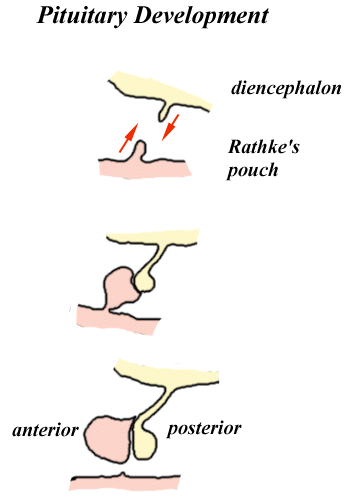The pituitary gland (hypophysis cerebri) is derived from 2 sources. The anterior lobe is an upgrowth of ectoderm from the roof of the stomodeum (primitive buccal cavity), while the posterior lobe is a down growth of neuroectoderm from the diencephalon.

4th week: a diverticulum, Rathke’s pouch, grows upwards from the roof of the stomodeum towards the developing brain.
As the upgrowth contacts a downgrowth from the brain, the infundibulum, Rathke’s stalk (connection between Rathke’s pouch and the Stomodeum) begin to degenerate.
By the 6th week: the Rathke’s stalk degenerates and Rathke’s pouch loses its connection with the stomodeum.
The cells of Rathke’s pouch proliferate to form the pars distalis, and extend up the anterior aspect of the infundibulum as the pars tuberalis. The posterior surface of Rathke’s pouch does not proliferate but forms the poorly developed pars intermedia.
The infundibulum having grown down from the floor of the diencephalon, expands as the axons of cells in the diencephalon grow down into it.
Summary:
Rathke’s pouch from stomodeum: Pars distalis, Pars tuberalis, Pars intermedia
Infundibulum from diencephalon: Pars nervosa, Stalk (infundibulum)
Congenital Anomalies of Pituitary Gland:
- Craniopharyngioma: Failure of degeneration of Rathke’s stalk
- Pharyngeal pituitary: Failure of ascending of buccal pituitary
- Agenesis of pituitary